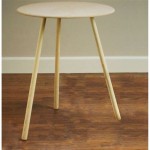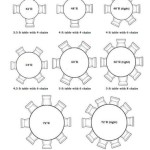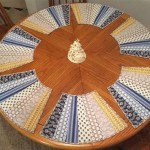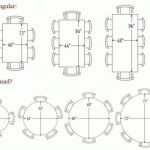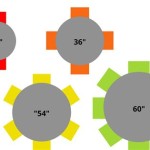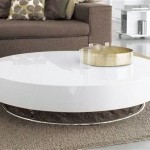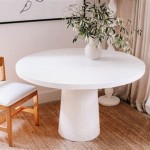How To Determine Round Tablecloth Size
Selecting the correct tablecloth size is essential for creating a polished and aesthetically pleasing table setting. A tablecloth that is too small can appear inadequate and fail to provide adequate protection for the table's surface. Conversely, a tablecloth that is excessively large can drape awkwardly and impede movement around the table. This article provides a comprehensive guide to accurately determining the appropriate round tablecloth size, ensuring a balanced and functional result.
Several factors contribute to determining the right tablecloth size, including the table's diameter and the desired drop length. Understanding these elements and applying accurate measurement techniques are crucial for achieving a visually appealing and practical table arrangement. Incorrect measurements often lead to purchasing a tablecloth that does not fit properly, resulting in unnecessary expenses and aesthetic disappointments.
Measuring Your Round Table's Diameter
The first step in selecting the correct round tablecloth size is to accurately measure the diameter of the table. The diameter is the distance across the table passing through the center. To obtain an accurate measurement, use a flexible measuring tape. Place one end of the measuring tape at the edge of the table and extend it straight across to the opposite edge, ensuring the tape passes directly through the center of the table. It is recommended to take this measurement multiple times to verify its accuracy, particularly if the table is old or appears slightly irregular in shape. An inaccurate diameter measurement will inevitably lead to an improperly sized tablecloth.
If it's challenging to hold the measuring tape perfectly straight across the table, enlist the help of another person to hold one end of the tape while you extend the other to the opposite side. Be mindful of any obstructions on the tabletop that could interfere with an accurate measurement. Also, ensure the measuring tape is level and not drooping, as this can introduce errors. Record the diameter measurement in inches, as most tablecloth sizes are specified in this unit.
For tables that are not perfectly round, it may be necessary to measure the diameter at several points and calculate the average. This will help to account for any irregularities in the table's shape and ensure the chosen tablecloth provides adequate coverage. If the table features an overhang, it's important to measure the diameter at the widest point of the overhang.
Calculating the Desired Tablecloth Drop
The "drop" refers to the length of the tablecloth that hangs over the edge of the table. The desired drop length is largely a matter of personal preference and the occasion. A longer drop generally implies a more formal setting, while a shorter drop is more appropriate for casual gatherings. The standard drop for dining tables ranges from 6 to 12 inches. A 6-inch drop is considered a minimal and casual option, whereas a 12-inch drop offers a more elegant and formal presentation. Some formal events may even feature a drop longer than 12 inches.
To calculate the required tablecloth size, the desired drop length must be considered. Multiply the desired drop length by two, because it accounts for the drop on both sides of the table. Then, add the result to the measured diameter of the table. For example, if a table has a diameter of 60 inches and a 10-inch drop is desired, the calculation would be as follows: (10 inches x 2) + 60 inches = 80 inches. Therefore, an 80-inch round tablecloth would be required.
It is important to consider the height of the chairs when making this decision. A drop that is too long could impede guests from comfortably sitting at the table. If chairs have armrests, ensure the drop clears the armrests to avoid any obstruction. Consider the event type and the overall aesthetic when determining the drop length. A tablecloth used for outdoor picnics might warrant a shorter drop to prevent it from dragging on the ground, while a tablecloth used for a formal indoor dinner party may benefit from a longer drop for a more sophisticated look.
Considering Other Factors and Common Mistakes
Beyond the table's diameter and desired drop, other factors may influence the final tablecloth selection. The material of the tablecloth can affect its drape and visual appeal. Heavier materials, such as linen or damask, tend to drape more elegantly than lighter materials, such as cotton or polyester. Tablecloths made from thicker fabrics may also require a slightly longer drop to achieve the desired visual effect.
Another factor to consider is the potential for shrinkage, especially with natural fabrics like cotton and linen. Pre-washing the tablecloth before the first use can help minimize shrinkage and ensure a consistent fit after subsequent washes. Always follow the manufacturer's care instructions to prevent damage to the fabric or alteration of its original size.
One common mistake is overlooking the thickness of the tabletop when measuring the diameter. While it may seem negligible, the thickness can subtly affect the accuracy of the measurement, especially with thicker tabletops. Always measure from the true edge of the tabletop to the opposite edge, rather than estimating based on the visible surface.
Another mistake is failing to account for the availability of tablecloth sizes. Tablecloths are often sold in standard sizes, such as 70 inches, 90 inches, 108 inches, and so on. It may be necessary to round up to the nearest available size if the calculated tablecloth size falls between standard sizes. Consider the potential for slight variations in the manufactured size of the tablecloth. A tablecloth that is slightly larger than required is generally preferable to one that is too small.
When purchasing a tablecloth online, carefully review the product description and specifications. Pay close attention to the stated dimensions and material composition. Check customer reviews to gain insights into the actual size, drape, and quality of the tablecloth. Be aware of potential color variations between the online image and the actual product. It's always a good idea to compare prices and read return policies before making a purchase.
For formal events, underlays or tablecloth protectors can be used beneath the tablecloth to add extra padding and protection to the table's surface. These underlays can also help improve the drape of the tablecloth and prevent it from slipping. Consider the color of the underlay and its potential impact on the overall appearance of the table setting.
When in doubt, it is often best to opt for a slightly larger tablecloth rather than one that is too small. A larger tablecloth can be adjusted or altered to achieve the desired fit, while a tablecloth that is too small will simply not provide adequate coverage. A professional seamstress can alter a tablecloth to the required size if necessary.
By carefully considering these factors and following the measurement techniques outlined above, individuals can accurately determine the appropriate round tablecloth size for any table and occasion. This ensures a professionally presented table setting that meets both functional and aesthetic requirements.

How To Choose The Correct Size Tablecloth For Your Table

How Do I Calculate The Right Linen Size For A Round Table Party Al Ltd

Tablecloth Size Guide Table Linen Hire Tips Plato

How Do I Calculate The Right Linen Size For A Round Table Party Al Ltd

3 Easy Ways To Measure Tablecloth Sizes Your Table Linens Size Guide

Tablecloth Size Round

How To Measure Your Table For A Tablecloth Wipe Away Tablecloths

Tablecloth Size Chart Asap Linen

How To For The Perfect Round Tablecloths Your Event Cv Linens

Let S Talk Linens The Ultimate Guide To Table Linen Sizes Party Al Ltd Pink Hippo Blog
Related Posts

